EMAIL THIS PAGE!
About the BOOK
The LEONARD BERNSTEIN Pages
The HILDEGARD BEHRENS Pages
Front Page
Leonard Bernstein:
the last 10 years
-a look at the book by T.R Seiler
Unbewußt, höchste Lust
- on the recording of Tristan
Heights of Rapture
- a foreword by Hildegard Behrens
***
Chronology of a
Life in Music:
The not-so-humble beginnings
Big time in the Big Apple
At the helm of the NYPO
The last 20 years
Discography
The Composer
The Conductor / Pianist
Videography:
The Teacher /
the Musician in performance
and in rehearsal
Books
by and on Bernstein
SITE MAP
Sign up for:
EMAIL UPDATES
GIVEAWAY!
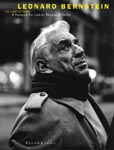
Buy the book!
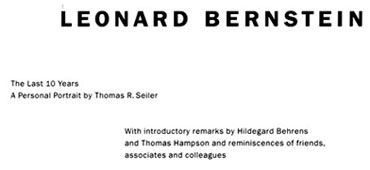
FanFaire thanks Edition Stemmle, Abbeville Press, and Ms. Behrens for permission to reproduce the text and b&w photos shown here.
Heights of Rapture - Depths of Melancholy
- by Hildegard Behrens
It is an honor and a challenge for me to write some introductory words for this wonderful volume on Leonard Bernstein. As many of his friends and contemporaries knew him much longer and perhaps better than I did, I would like to limit myself to my most powerful reminiscences of the years we played together- the last decade of Bernstein's life, during which Thomas R. Seiler also captured his photographic images of their travels together.
I was first personally introduced to Bernstein at a dinner in 1980 after one of his concerts in Munich. The evening was aglow and when he told me that he was planning to do Tristan with me I was so delighted I could hardly speak. The work began between Christmas and New Year's. It was an enormous project with three acts spread over January, April and November. That I would give birth to my daughter Sara that same year, just six weeks before the third act, was unbeknown even to me as we started Tristan.
| The
live concerts in the Herkulessaal with Bernstein's much beloved Bavarian
Radio Symphony Orchestra were broadcast simultaneously on radio and
television, as well as being recorded for video and LP. We singers
stood on a high platform behind the orchestra. Each of us had a whole
bouquet of microphones in front of us and was expected to gesticulate
a little as well. An expectant atmosphere weighed on the entire event
and on each individual, but it soon became clear that the higher the
voltage, the better the maestro felt. Bernstein once said, |
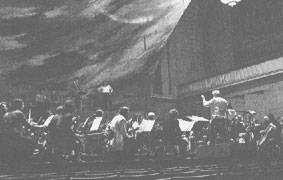 In rehearsal at the Herkulessaal (Munich) |
| "When I conduct Beethoven, I don't care whether I conduct the way Beethoven would have conducted. What's important is that I'm convinced that what I've done is in the spirit of Beethoven, even if I know that Beethoven would have done it differently. One is not a slave to a work of the past, but a creator here and now!" |
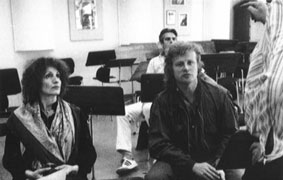 Hildegard Behrens and Peter Hofmann: Bernstein's Isolde and Tristan |
In the same breathtaking way, Bernstein took possession of Tristan. As it was Peter Hofmann's debut in this role, the maestro was touchingly attentive in his efforts to help him past all the precipices and chasms of the part. Yet in so doing he was forced to restrain his own urge to identify with the Tristan role. He seemed to try to compensate for this by drawing all the more on the depths of Isolde's character. He sang and hummed my cantilennas along with me, his mind focused inwards. As we came to Isolde's central phrase, "Er sah mir in die Augen," he brought the orchestra almost - as it seemed to me - to a halt through an excessive rallentando. I went on the offensive and protested: "Lenny, you're not leaving me anything for my ritardando! I'm Isolde, you don't have to be everyone!" He was a "zealous god," and after this first act, a slightly quarrelsome atmosphere smoldered between us. |
 After one rehearsal, Lenny sat down at a harpsichord that happened
to be there. Dressed in a white bathrobe wih a cigarette holder in
his mouth, he made a fascinating foray into the harmonic structure
of the Tristan score. Unforgettable!
After one rehearsal, Lenny sat down at a harpsichord that happened
to be there. Dressed in a white bathrobe wih a cigarette holder in
his mouth, he made a fascinating foray into the harmonic structure
of the Tristan score. Unforgettable!In Vienna, Munich and Bregenz I performed his third symphony, Kaddish, together with Bernstein himself, who corrected my Hebrew unrelentingly. He had premiered this moving piece with his deceased wife, Felicia Montealegre. Lenny accompanied me on the piano at several charity galas in New York in which we performed his own vocal works or Marlene Dietrich's evergreens from Der Blaue Engel. Lenny would be dressed in a sassy white tuxedo with glistening Lurex trousers and patent leather buckled shoes and I would be in Marlene-look with a midnight-blue evening dress, hat, cigarette holder and rhinestone-studded high heels. We had a load of fun; indeed, parties were held whenever the occasion called for it, for example after one wonderful performance of West Side Story on Broadway to which Peter Hofmann and I were invited by Lenny. |
|
As I leaf through this volume and look at these so very characteristic photographs, I think of the stories from Bernstein's life that he liked to tell late at night. The intoxicating effect of life and profound melancholy sapped the substance of his volcanic temperament. Ruthless exploitation of his character deeply scored the bedrock. I can remember how he told us in New York that a team of doctors was attempting to teach him how to sleep again. Like almost no one else, Bernstein bequeathed to young people the Olympian fire, the flame of musical passion. His open-mindedness ("There is no such thing as U- and E- Musik, only good and bad music!"), his own compositions, his great admiration for the Beatles - all these confirmed his "credibility" and youthfulness of heart to the younger generation. In 1997, when I performed a lieder recital with Christoph Eschenbach in Japan at the Pacific Festival - which Bernstein had initiated in 1990 for young musicians from throughout the world (and at which he allegedly once more felt happy and alive shortly before his death) - we played one of his works for voice, piano and cello (Dream with me) as part of the encore. The first cellist from the Vienna Philharmonic (Friedrich Dolezal) had come over from another auditorium to do this encore with us after his own concert had finished. When I announced the piece, a cheer went up in the young audience. The spark of the Bernstein name had spontaneously combusted! |
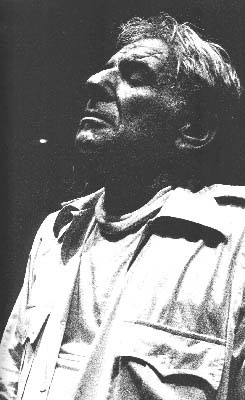 |
| <<< Back | Hildegard Behrens' Isolde | "Unbewußt, höchste Lust." | On the plane to Zurich...>>> |
| Photos and text reproduced with permission of the publisher Edition Stemmle, the US Distributor Abbeville Press, and Ms. Behrens, who wrote both the German and English text (Text: pp 18-19, Photos: pp 21, 24, 26). Design and Original Content: © 1997-2008. FanFaire LLC. All rights reserved. |
|||